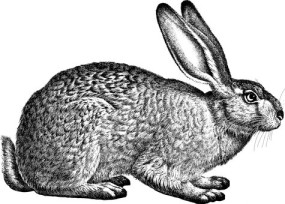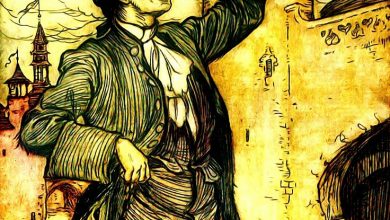
Virginia Woolf’s Lappin and Lapinova is a brilliant tale that engages deeply with the themes of love, class, discontent, connection, escape independence, and control. An unnamed narrator tells the story in the third person. The story follows Rosalind’s marriage to Ernest Thorburn for the first few years, a relationship fueled by their fantasy of themselves as Queen Lapinova (a hare) and King Lappin (a rabbit). The story has many interpretation possibilities because of its fairy tale attributes and intriguing ambiguities.
Lappin and Lapinova was one of the stories in her final collection of short stories, A Haunted House and Other Stories.
Lappin and Lapinova | Summary
When the story begins, Rosalind and Ernest Thorburn have recently gotten married. They’re head over heels in love. Rosalind starts to suspect that her husband does not resemble Ernest one morning. Instead, she decides he resembles a rabbit. Outsiders may not notice Ernest’s resemblance to a rabbit (“lapin” is French for rabbit), but he and his wife soon create private mythology in which they see each other like rabbits. This mythology provides the couple with their private world. Rosalind is almost alone in the world, whereas Ernest comes from a large family. Ernest’s family appears to be country gentry.
During his parent’s fiftieth-anniversary party Rosalind realizes how different she is from the Thorburn family. That party was something she dreaded. However, it was unavoidable. As she walked upstairs, she resented the fact that she was an only child and an orphan. The Thorburns gathered in the grand drawing-room, which featured satin wallpaper and gleaming family portraits. The living Thorburns looked a lot like the painted ones, except they had real lips, which were full of jokes about schoolrooms and how they had pulled the chair out from under the governess, and jokes about frogs and how they had stuffed them between the virgin sheets of maiden ladies. Candlesticks, cigar boxes, and chains adorned the tables and chairs all around them, each stamped with the goldsmith’s proof that it was solid gold, hall-marked, and authentic. Her gift, however, was a small pinchbeck box with holes, as well as an old sand caster which was an eighteenth-century relic that was once used to sprinkle sand over wet ink. In the age of blotting paper, she thought it was a rather pointless present.
During dinner, she was feeling restless but she heard a woman saying
“They breed so.” Then John bawled:
“Little devils! . . . Shoot’em! Jump on ’em with big boots! That’s the only way to deal with ’em . . . rabbits!”.
She associates the word rabbit with magic, and she imagines the entire Thorburn family resembling someone else and losing their identities. Her husband’s father is a poacher who hides seals, enamel boxes, trifles and hides from his wife. Celia, the unmarried daughter, has the appearance of a white ferret with pink eyes, and her mother-in-law has the appearance of a squire. She was Lapinova, and her mother-in-law was thanking her children, who despise her before the party came to an end.
This pretence goes on for two years. Now, Rosalind’s mother in law is dead and on another anniversary of the gold-wedding party Rosalind suddenly wakes up in the middle of the night. She feels as if Lappin is dead and being distraught disturbs her sleeping husband. He gets angry at her for disturbing him and asks her to stop talking rubbish. The next day she is restless as if she has lost something. Ernest comes home and she wails and tells him that Lapinova is dead. And he replies:
“Yes,” he said at length. “Poor Lapinova . . .” He straightened his tie at the looking glass over the mantelpiece.
“Caught in a trap,” he said, “killed,” and sat down and read the newspaper.
The story ends with the end of their marriage.
Lappin and Lapinova | Analysis
Ernest and Rosalind Thorburn are young newlyweds in “Lappin and Lapinova” Rosalind imagines herself and her husband as King Lappin and Queen Lapinova, two rabbits who create their imaginary world. Rosalind clings to the fantasy to cope with her husband’s large, overwhelming family and her marital dissatisfaction. She dissociates on several occasions and wonders what she’s doing and why she’s married to Ernest. Ernest eventually abandons the game, and Rosalind realizes she has lost both King Lappin and her alter ego Lapinova.
Ernest woke, and seeing her sitting bolt upright beside him he asked:
“What’s the matter?”
“I thought my rabbit was dead!” she whimpered. Ernest was angry.
“Don’t talk such rubbish, Rosalind,” he said. “Lie down and go to sleep.”
He turned over. In another moment he was sound asleep and snoring.
“So that was the end of that marriage”, the story concludes abruptly, a rude awakening from the fantasy of an enchanted fairy tale ruled by rabbits.
When it comes to Ernest’s family, Rosalind considers them to be old-fashioned. This could be significant because Woolf may be emphasizing the class divide that existed at the time the story was written. People from lower social classes no longer had the same respect for those from higher social classes. Rosalind is completely reliant on Ernest to cheer her up, and the only way he can do so is by twitching his nose like a rabbit. It seems as though Rosalind is dissatisfied with life and finds happiness only when she and Ernest play their game together. This is noteworthy because Rosalind could be lonely. Ernest appears to be the centre of her universe. Rosalind uses the game she and Ernest play with each other as a form of escape. For her marriage to headway, she is completely dependent on a children’s game. Rosalind appears to be afraid of the outside world and Ernest’s family, and as a result, she requires a way to escape from the realities of life. For the first two years of her marriage to Ernest, she is successful in this endeavour. Rosalind is happy once she has her game that she can play with Ernest. It’s also worth noting that Rosalind relies on Ernest to play Lappin throughout the story. This could indicate that Woolf is delving into the domain of male dominance in society. Rosalind is emotionally, mentally, and financially reliant on Ernest. In a male-dominated society, females are treated like second-class citizens.
Lappin and Lapinova | Themes
Themes in Lappin and Lapinova include love, class, discontent, connection, escape, independence, and control. Rosalind’s attitude toward her husband’s family and the kind of gifts they received on their anniversary reflects the theme of class. The gentry’s decay is symbolized by the decaying mansion. In just a few pages, Woolf brilliantly depicts how small details can have a big impact on relationships. She demonstrates how delicate love can be at times. For the first two years, their relationship survived but soon Ernest lost interest. You could read this story and conclude that private myths are necessary to support a marriage, or you could conclude that they hide the true nature of relationships from shallow participants.
Rosalind appears to be afraid and thus requires a means of escape from the realities of life. For the first two years of her marriage to Ernest, she is successful in this endeavour. Rosalind is happy once she has her game that she can play with Ernest. The story depicts human communion’s success and failure. The married couple becomes estranged because the husband is unable to truly share his wife’s imaginative fantasy of the two of them as rabbit and hare, instead of reverting to his pragmatic and stolid family heritage and an arrogant masculine impatience.
Lappin and Lapinova | Character Sketch
Rosalind Ernest Thorburn – Rosalind is the wife of Mr Ernest Thorburn. She tries to create a mythology for her to make her marriage work. She is the dissatisfied unhappy wife who tries her best to understand her surroundings and when failed creates an alternative world as a coping mechanism. She calls herself Queen Lapinova and her husband King Lappin and pretends to play a happy game that she believes reflects a happy marriage but turns out to be a disaster.
Ernest Thorburn – Ernest is the husband who is fantasized as a rabbit by his wife. Initially, he participates in his wife’s mythology but later stops being a part of it leading to the end of their marriage. He represents men who don’t take much interest in their wives after a while and usually ignore them.
Lappin and Lapinova | Literary Devices
Foreshadowing – The fact that Rosalind is still strange with Ernest’s name after they marry could be interpreted as foreshadowing, as Woolf may be preparing the reader for what happens at the end of the story and the breakdown of Rosalind and Ernest’s marriage. Something that appears to be based on Rosalind’s belief that Ernest is cold-hearted when she informs him that Lapinova has died.
Repetition – Woolf uses this literary device to reiterate the idea that how desperate Rosalind is to accept her mythology as if she is trying to persuade herself that is the only way for the marriage to survive.
“Lappin, Lappin, King Lappin,” she repeated. It seemed to suit him exactly; he was not Ernest, he was King Lappin.
Why? She did not know.
Simile –
“It’s because you’re like a rabbit, Ernest,” she said. “Like a wild rabbit,” she added, looking at him. “A hunting rabbit; a King Rabbit; a rabbit that makes laws for all the other rabbits.”
Lappin and Lapinova | About the Author – Virginia Woolf
Virginia Woolf (1882–1941) is widely regarded as one of the twentieth century’s most innovative writers. She was also a prolific essayist, diarist, letter writer, and biographer. Woolf’s work captures the fast-changing world in which she worked, both in style and subject matter, from changes in gender roles, sexuality, and class to technologies like cars and cinema. Woolf’s work explores the key motifs of modernism, including the subconscious, time, perception, the city, and the impact of war. Her stream of consciousness technique enabled her to depict her character’s inner lives as well as the montage-like imprint of memory. Some of her most important works are The Voyage Out (1915), Jacob’s Room (1922), Orlando (1928), and The Waves (1928), in addition to Mrs Dalloway (1925) and To the Lighthouse (1927). A Room of One’s Own was her most famous essay.




